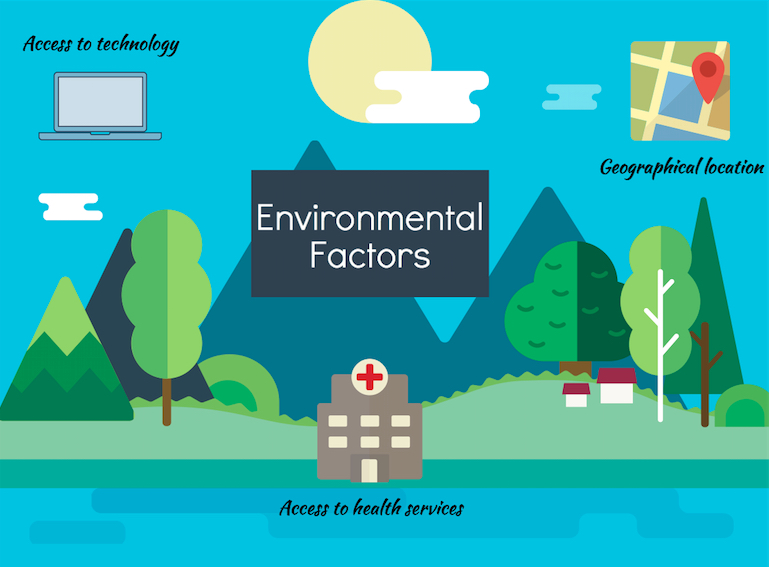Environmental factors are the final of the determinants of health listed in the HSC PDHPE syllabus. Environmental factors include not just geographical location but also access to health services and technology. When it comes to the environment, there are both natural and built aspects of the environment.
Geographical location
Where someone lives can greatly determine their health. Within Australia there are people who are homeless, others who live in third world conditions, some who live in rural and remote areas, while many live in cities around the country. Someone’s geographical location can mean that they are exposed to pollution, or have limited access to fresh water. Geographical location can mean that foods purchased have had to travel further and have less nutrients in them as well as meaning a lack of educational or employment opportunities.
AIHW also identifies a range of environmental determinants of health, including:
- Contamination of food and water
- Vectorborne diseases transmitted by insects and other animals
- Disease caused by air pollution or exposure to chemicals
- Injuries that are a results of workplace or traffic systems
- Disasters or changes in ecological systems associated with climate change
Examples of the environment leading to chronic disease include: high UV exposure leading to higher rates of skin cancer, air pollution or dampness or mould exposure leading to respiratory diseases and infections, and increased asthmatic episodes. Event eh design of the environment “for example, street connectivity, land use patterns, residential density, encourages physical activity and active forms of transport; inverse relationship with obesity.”[1]
Environmental factors affect one-another. Where someone lives can influence their access to health services. There are locations in Australia that are hours away from the closest hospital. People who live in rural and remote areas have less access to medical technology and fewer health specialists. Many are required to travel to major cities, particularly for kidney dialysis, which is needed on a regular basis.
The video below is Episode 2 from the SBS series “First Contact”. The beginning o this video shows what life is like on Elcho Island, and discusses why this environment is like this. Such an environment, including poor housing, a lack of access to health services and much more has a negative impact on health.
Access to health services
Someone with easy access to health services is more likely to have better health outcomes than someone who has to travel long distances or cannot afford to access particular health services. As such, this environmental factor relates to socioeconomic factors as well as the other environmental factors.
Accessing health services requires both money and physical access. People who live in rural or remote areas have less access to health services, with few specialists, fewer hospitals (with staff shortages), and a shortage of other health care providers, such as nutritionist, physiotherapists, radiologists and more. A lack of access means people who require these services either have to travel to get it, or do not get the benefits at all.
This is particularly the case for those with lower incomes. They cannot afford particular health care services, such as dental, resulting in poorer health outcomes, such as increased cavities, losing teeth, or chronic pain from arthritis. Chronic disease has a very high burden of disease, resulting in people taking me time off work, costing the government more money to treat and people suffer physically, socially, mentally, emotionally and physically from the diseases.

Access to technology
Access to technology includes access to health care technology, such as kidney dialysis machines, as well as access to technology for knowledge, such as the internet. A person’s access to technology, just like their access to health services, is affected by their geographical location and socioeconomic status.
Accessing surgical technology or the latest hearing technology requires access to the health service that utilise and provide such technology, but also require money. There are many technologies that re paid for through Medicare within the public health care system, but many are only available through private health providers, meaning they cost the consumer.
[1] http://www.aihw.gov.au/chronic-disease/risk-factors/ch2/#other-risk
